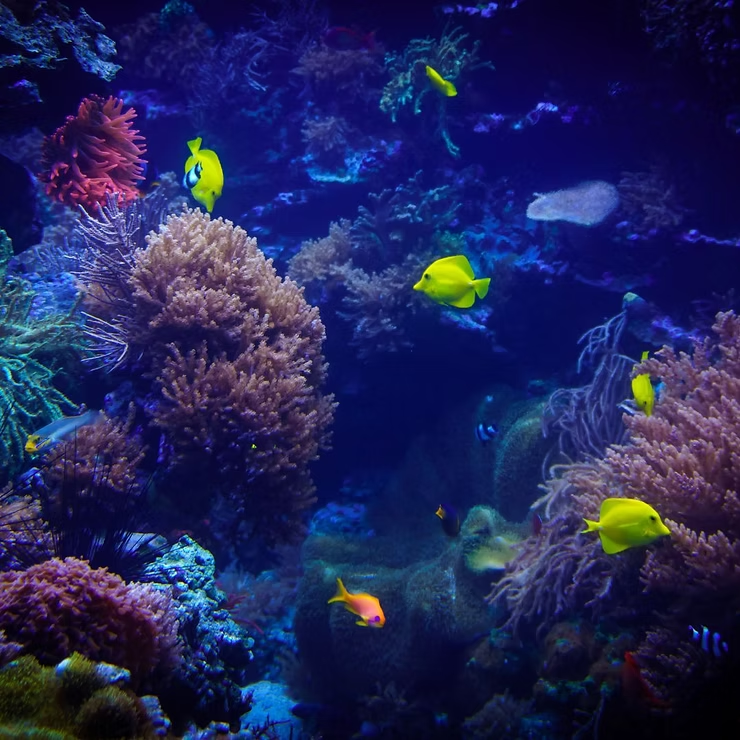Marine Biofluorescence: Nature’s Living Light
Marine biofluorescence is a captivating phenomenon where ocean species absorb light, transform it, and emit radiant colors. Far more than a visual spectacle, it is a survival tool, a form of communication, and an ecological indicator. From glowing corals to stealthy sharks, biofluorescence reveals the ocean’s complexity while highlighting the importance of conservation and research.
The Science Behind the Glow
Biofluorescence occurs when organisms absorb sunlight or moonlight, excite special proteins, and re-emit light at longer wavelengths. This process produces striking greens, reds, and blues visible only under certain conditions. Beyond aesthetics, this adaptation helps creatures communicate, camouflage, and attract mates in the dark depths of the sea.
Fluorescent Life Across the Ocean
Small but Significant Creatures
Zooplankton and tiny fish use their glow to navigate, hide, and interact. These minute organisms, though often overlooked, play a massive role in sustaining marine ecosystems.
Larger Marine Icons
- Mandarinfish display psychedelic patterns to court mates.
- Pufferfish create intricate sand circles enhanced by glowing accents.
- Corals emit vivid fluorescence, often linked to their health and resilience.
- Sharks and Rays use glowing patterns to communicate or conceal themselves in dim waters.
Roles of Biofluorescence in Survival
- Communication: Signaling readiness to mate, warning predators, or maintaining pod cohesion.
- Camouflage: Blending with filtered light to remain invisible in the water column.
- Attraction: Drawing prey closer with irresistible glows.
- Protection: Coral fluorescence as a defense against UV radiation and stress.
Exploring Biofluorescence
Tools and Technology
Modern exploration relies on blue light, yellow filters, and ultraviolet sources to reveal biofluorescence. Researchers use high-tech submersibles, long-term seafloor observatories, and underwater cameras to capture glowing displays.
The Role of Citizen Science
Divers and ocean enthusiasts contribute data by sharing sightings, photos, and observations. These community-driven efforts expand research reach while fostering ocean stewardship.
Coral Reefs: Neon Guardians of the Sea
Coral reefs act as glowing hubs of biodiversity. Healthy corals emit bright patterns, while stressed ones often lose fluorescence, signaling environmental danger. Restoration projects, artificial reefs, and sustainable ecotourism are vital in protecting these radiant ecosystems.
Conservation in Colors
Marine Protected Areas
MPAs safeguard habitats where biofluorescent life thrives, offering safe zones for research, tourism, and education. They help balance conservation with responsible human interaction.
Sustainable Ecotourism
Guided night dives and educational tours showcase the wonder of biofluorescence while supporting local conservation initiatives. These responsible experiences turn fascination into awareness and action.
Unanswered Questions and Future Research
Despite advances, mysteries remain. Scientists continue to explore how biofluorescence evolved, its role in species interactions, and its potential as a tool to monitor ocean health. Each glowing discovery pushes marine biology deeper into uncharted territory.
Conclusion
Biofluorescence is more than an oceanic light show—it is a language of survival, adaptation, and beauty. From tiny plankton to majestic sharks, glowing species remind us of the ocean’s resilience and fragility. Protecting these habitats ensures that future generations will continue to witness the sea’s living palette, a luminous legacy of evolution and conservation.
Frequently Asked Questions
What is marine biofluorescence?
It is the process where marine organisms absorb light and re-emit it in different colors for survival and communication.
Which creatures glow?
Corals, jellyfish, sharks, rays, fish, zooplankton, and even some turtles and seabirds exhibit biofluorescence.
How is it studied?
Scientists use blue light, UV sources, and filters, alongside underwater photography and advanced imaging tools.
Why is it important?
It provides insights into reef health, species behavior, and the impact of environmental stressors.
Can people experience it?
Yes, aquariums and guided night dives showcase biofluorescence, while virtual tours offer remote access to glowing seas.

